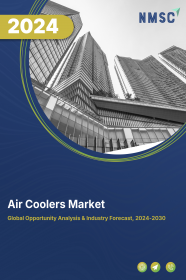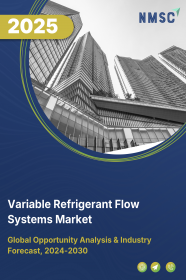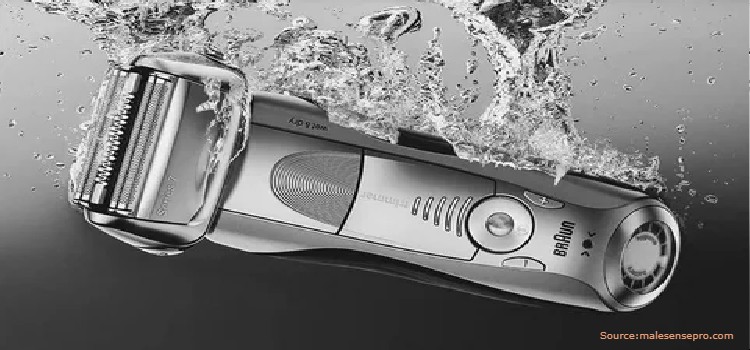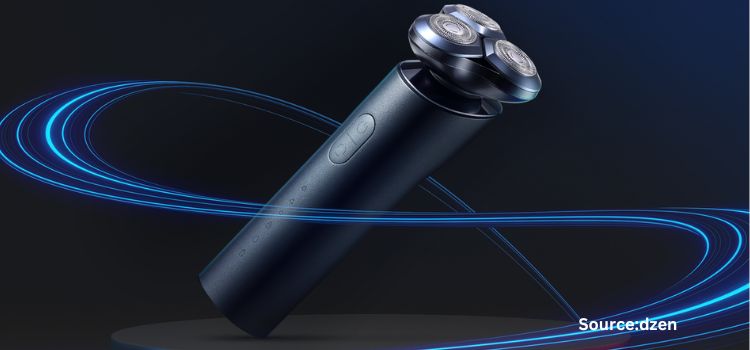
Air Coolers Market by Type (Tower, Desert, and Others), by Size (Spot Coolers, Medium Space Coolers, and Large Space Coolers), by and Application (Residential and Commercial)– Global Opportunity Analysis and Industry Forecast, 2024–2030
Industry: Retail and Consumer | Publish Date: 06-Mar-2024 | No of Pages: 212 | No. of Tables: 200 | No. of Figures: 165 | Format: PDF | Report Code : N/A
US Tariff Impact on Air Coolers Market
Trump Tariffs Are Reshaping Global Business
Air Coolers Market Overview
The global Air Coolers Market size was valued at USD 1.93 billion in 2023 and is expected to reach USD 3.31 billion by 2030, with a CAGR of 7.5% from 2024 to 2030. Air coolers, also known as evaporative coolers or swamp coolers, are devices designed to cool indoor or outdoor spaces by utilizing the natural process of evaporation. These appliances typically consist of a fan, a water reservoir, and porous pads or filters.
Air coolers offer benefits such as lower energy consumption, eco-friendliness, and affordability compared to conventional cooling methods. They come in various sizes and capacities to suit different applications, ranging from small portable units for personal use to larger systems for commercial and industrial settings.
Rising Global Temperature Fuels the Expansion of Air Coolers Market
Rising global temperatures are a significant force driving the growth of the air coolers market. As per the 2024 Annual Climate Report from the National Oceanic and Atmospheric Administration (NOAA), global temperatures have consistently risen since 1850, with an increase of approximately 0.11°F (0.06°C) per decade. Over a century, this has resulted in a total temperature increase of around 2°F.
Moreover, the study conducted by the World Weather Attribution, an academic collaboration studying extreme event attribution and calculations of the impact of climate change on extreme meteorological events, further highlights the tangible consequences of this warming trend.
In July 2023, extreme heatwaves swept across various parts of the Northern Hemisphere, impacting regions such as the Southwest of the US and Mexico, Southern Europe, and China. Tragically, these heatwaves resulted in numerous heat-related fatalities, with confirmed deaths occurring in the US, including migrants along the US-Mexican border, and over 200 fatalities reported in Mexico alone.
Other affected countries, including Spain, Italy, Greece, Cyprus, Algeria, and China, also witnessed heat-related deaths and a significant surge in hospitalizations due to heat-related illnesses such as heatstroke, heat cramps, and heat exhaustion.
There has been a growing demand for effective cooling solutions in response to these escalating temperatures and their associated risks to public health and well-being. Swamp coolers have emerged as a vital technology to combat the challenges posed by rising temperatures.
Air coolers relieve extreme heat without exacerbating environmental concerns such as global warming and ozone layer depletion, offering efficient and affordable cooling mechanisms.
Consequently, the air chiller market is experiencing notable growth as individuals, communities, and businesses seek viable solutions to address the escalating impacts of global warming and heat waves.
Growing Urbanization Increases the Demand for Air Coolers
The growth of urbanization is a key driver behind the expanding air cooler market globally, closely tied to the increasing demand for cooling solutions in densely populated urban areas.
According to data from the World Bank, 56% of the world's population, totaling 4.4 billion people, currently reside in cities. This trend is projected to persist, with urban populations anticipated to more than double by 2050, and at this point, nearly 7 out of 10 individuals will be urban dwellers.
Air coolers offer a cost-effective and energy-efficient alternative in densely populated urban areas, where traditional air conditioning systems may be prohibitively expensive. Their portability and ease of installation make them particularly suitable for urban living arrangements, where space constraints and rental properties are typical.
Competition from Air Conditioning Systems Hinders Market Expansion
Competition from air conditioning systems significantly restricts the growth of the air cooler market. Although typically more expensive to purchase and maintain, traditional air conditioning systems offer superior cooling capacity and precise temperature control compared to air coolers. In markets where air conditioning infrastructure is well-established, air coolers face stiff competition from these more advanced systems.
The latest data from the 2020 Residential Energy Consumption Survey conducted by the US Energy Information Administration highlights the dominance of air conditioning in households, with 88% of US households utilizing air conditioning systems.
Additionally, a recent survey conducted by Panasonic among 10,000 respondents in Japan indicates widespread adoption of air conditioning, with 93.2% of households owning at least one air conditioner. This high penetration rate of air conditioning systems underscores the challenge air coolers face in capturing market share, particularly in regions where air conditioning is considered the norm.
Technological Advancements to Create Future Market Prospects
Technological advancements represent a significant opportunity for the future growth of the air coolers market. Continuous innovation has resulted in the development of increasingly efficient and feature-rich air cooler models.
These advancements encompass various aspects, including enhancements in fan design, evaporative cooling technology, and the integration of intelligent features such as remote control and programmable settings, collectively enhancing the overall user experience.
As technological advancements evolve, the air cooler market is poised to benefit from introducing innovative features and capabilities that address consumer needs and preferences, such as energy efficiency, portability and space-saving design, quiet operation, and air quality improvement. These technological advancements enhance the performance and functionality of air coolers and contribute to their differentiation in a competitive market landscape.
Moreover, integrating intelligent technologies opens up opportunities for connectivity and interoperability with other smart home devices, further enhancing the appeal and adoption of air coolers among tech-savvy consumers.
Asia-Pacific Dominates the Air Coolers Market, with the Highest CAGR till 2030
The Asia-Pacific air cooler market emerges as the dominant force, commanding a staggering 43% of the global market share and boasting the highest growth rate among all other regions.
This region's prominence is underscored by the significant market presence of countries like China, India, and Japan, which collectively dominate the market. Among these, China leads the pack with a commanding 53% market share, followed closely by India and Japan.
The Asia-Pacific region encompasses diverse economies and demographics, each with unique factors propelling the growth of the air cooler market. Rapid urbanization across many countries in the region has led to an increasing demand for indoor cooling solutions.
According to the Central Intelligence Agency, Japan's urban population accounts for 92% of the total population in 2023. Moreover, as the second-largest economy globally, China boasts a formidable nominal GDP of USD 17.963 trillion in 2022, growing at 2.99% annually.
This economic strength translates into increased consumer spending power, driving demand for comfort-enhancing appliances like air coolers. With a growing middle class and urban population, the demand for indoor climate control solutions is on the rise, further fueling the growth of the air cooler market.
Competitive Landscape
Several market players operating in the air coolers market landscape include Symphony Ltd, Midea Group, Voltas, Havells India Limited, Portacool LLC, Bajaj Electricals Ltd., Crompton Greaves Consumer Electricals Ltd., Orient Electric, Usha International, Fujian Jinghui Environmental Technology Co. Ltd., and others. These market players are adopting strategies, such as product launches, across various regions, to maintain their dominance in the Air Coolers industry.
For instance, in October 2023, Portacool LLC launched its Apex Air Cooler Series as a new product line of portable evaporative coolers. The apex series represents the most advanced, efficient, and effective line of portable evaporative coolers.
Moreover, in April 2023, Symphony launched the world's first air cooler range powered by BLDC (Brushless DC) technology. This new range of air coolers consumes up to 60% less power compared to other air coolers, resulting in significant energy savings.
Additionally, in March 2023, Bajaj launched its latest range of air coolers equipped with the 'DuraMarine Pump' through a pan-India. The new range is a part of the refreshed portfolio of home appliances based on the promise of durability and is high endurance, aesthetically pleasing, and low maintenance.
Air Coolers Market Key Segments
By Product Type
-
Tower
-
Desert
-
Other Types
By Size
-
Spot Coolers
-
Medium Space Coolers
-
Large Space Coolers
By Application
-
Residential
-
Commercial
By Region
-
North America
-
The U.S.
-
Canada
-
Mexico
-
-
Europe
-
The UK
-
Germany
-
France
-
Spain
-
Italy
-
Netherlands
-
Denmark
-
Finland
-
Norway
-
Sweden
-
Russia
-
Rest of Europe
-
-
Asia-Pacific
-
China
-
Japan
-
India
-
South Korea
-
Australia
-
Indonesia
-
Singapore
-
Taiwan
-
Thailand
-
Rest of Asia-Pacific
-
-
Rest of the World (RoW)
-
Latin America
-
Middle East
-
Africa
-
REPORT SCOPE AND SEGMENTATION:
|
Parameters |
Details |
|
Market Size in 2023 |
USD 1.93 Billion |
|
Revenue Forecast in 2030 |
USD 3.31 Billion |
|
Growth Rate |
CAGR of 7.5% from 2024 to 2030 |
|
Analysis Period |
2023–2030 |
|
Base Year Considered |
2023 |
|
Forecast Period |
2024–2030 |
|
Market Size Estimation |
Billion (USD) |
|
Growth Factors |
|
|
Countries Covered |
28 |
|
Companies Profiled |
10 |
|
Market Share |
Available for 10 companies |
|
Customization Scope |
Free customization (equivalent up to 80 working hours of analysts) after purchase. Addition or alteration to country, regional, and segment scope. |
|
Pricing and Purchase Options |
Avail customized purchase options to meet your exact research needs. |
Key Players
-
Symphony Ltd.
-
Midea Group
-
Voltas
-
Havells India Limited
-
Portacool LLC
-
Bajaj Electricals Ltd.
-
Crompton Greaves Consumer Electricals Ltd.
-
Orient Electric
-
Usha International
-
Fujian Jinghui Environmental Technology Co. Ltd.

















 Speak to Our Analyst
Speak to Our Analyst





















